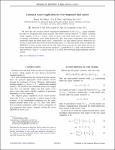Item Infomation
Full metadata record
| DC Field | Value | Language |
|---|---|---|
| dc.contributor.advisor | Cao H. Nam | - |
| dc.contributor.advisor | Duong Van Loi | - |
| dc.contributor.author | Phung Van Dong | - |
| dc.date.accessioned | 2021-07-06T03:20:54Z | - |
| dc.date.available | 2021-07-06T03:20:54Z | - |
| dc.date.issued | 2021 | - |
| dc.identifier.uri | https://journals.aps.org/prd/abstract/10.1103/PhysRevD.103.095016 | - |
| dc.identifier.uri | https://dlib.phenikaa-uni.edu.vn/handle/PNK/1961 | - |
| dc.description | Q1 | vi |
| dc.description.abstract | We show that the canonical seesaw mechanism implemented by the U ( 1 ) B − L gauge symmetry provides two-component dark matter naturally. The seesaw scale that breaks B − L defines a residual gauge symmetry to be Z 6 = Z 2 ⊗ Z 3 , where Z 2 leads to the usual matter parity, while Z 3 is newly recognized, transforming quark fields nontrivially. The dark matter components—that transform nontrivially under the matter parity and Z 3 , respectively—can gain arbitrary masses, despite the fact that the Z 3 dark matter may be heavier than the light quarks u , d . This dark matter setup can address the XENON1T anomaly recently observed and other observables, given that the dark matter masses are nearly degenerate, heavier than the electron and the B − L gauge boson Z ′ , as well as the fast-moving Z 3 dark matter has a large B − L charge, while the Z ′ is viably below the beam dump experiment sensitive regime. | vi |
| dc.language.iso | en | vi |
| dc.publisher | Phys. Rev. D | vi |
| dc.title | Canonical seesaw implication for two-component dark matter | vi |
| dc.type | Article | vi |
| eperson.identifier.doi | https://doi.org/10.1103/PhysRevD.103.095016 | - |
| Appears in Collections | ||
| Bài báo khoa học | ||
Files in This Item:

